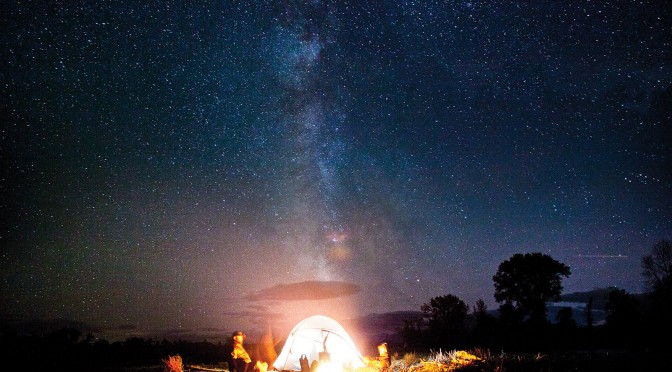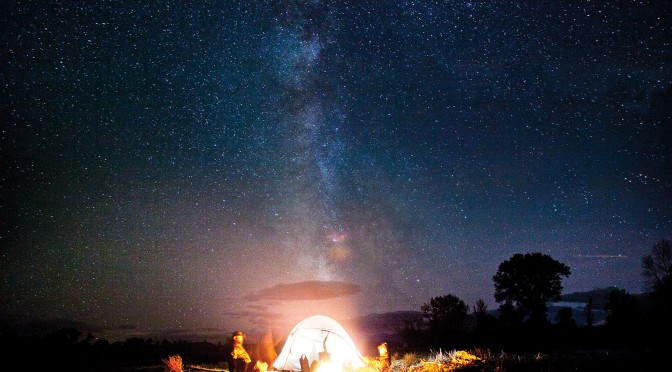by Jack Taylor
A guide to camping around the Bozone.
A camping or backpacking trip is one of the easiest, and quite possibly the best, ways to immerse yourself in the outdoors. Spending a night (or multiple nights) in the woods will calm your nerves, humble your mind, and invigorate your soul. When a trip is well executed, you’ll be rewarded with a sense of achievement and satisfaction. If things go awry, you’ll build resilience, learn from your mistakes, and certainly get a good story out of it. Most trips are a mixed bag of solid accomplishment and unplanned adventure. Here are some tips to help with logistics, so that you’ll have greater capacity for exploration. After all, you’d rather come home with a boastful tale about getting lost in the dark and navigating by starlight, than a dejected account of bringing the wrong type of stove gas and eating all your meals cold-soaked.
Where to Go
Our favorite place to go camping is… wait, did you really think we were going to tell you? Part of the fun in planning a trip is figuring out where to go! There’s nothing so satisfying as the process of discovery. That said, here are some general guidelines as you’re poring over the maps.
U.S. Forest Service land is perhaps the most popular option for overnight outings around here. From established campgrounds equipped with amenities, to vast swaths of unmarred wilderness, you’ll find the full gamut of camping and backpacking opportunities. Most of our nearby mountain ranges are almost entirely designated as National Forest (read: public) land.
State Parks and Fishing Access Sites (FASs) offer state-managed campgrounds, usually adjacent to water bodies or historical sites. Using these lands requires the purchase of an $8 annual Montana Conservation License, which can easily be obtained at fwp.mt.gov. The fee goes directly toward maintaining the sites.
Bureau of Land Management (BLM) land is more sparse around Bozeman, but it offers camping opportunities near some popular recreation sites. The campsites are generally primitive, with no amenities—save perhaps a fire ring. So plan ahead, and have a means of disposing your waste.
On that note, regardless of where you go, practice leaving no trace. Look up the “Leave-No-Trace Principles,” or just follow this rule: leave it better than you found it. That means no trash, a clean firepit, and in general just an attractive campsite for the next person who comes along.
Group Size
The ideal number of people for a camping or backpacking trip will depend on your objective. But whether it’s a solo peak-bagging mission or a river trip with a crowd of two dozen, group size is an important consideration in planning.
When solo, you can make all the decisions yourself with no external conflict. You’ll be less distracted, and will probably feel more immersed in the environment. But solo outings are riskier, as you’re self-reliant. Plus, in a group, you can work as a team and socialize. Conflict is almost inevitable, but working through it is a good skill to practice.
In the backcountry, where we go to experience pristine nature, groups of more than five people can have a significant impact on other travelers. If you’re in a large party, consider splitting into smaller teams while on the trail. You can reconvene at camp, but be especially mindful of encroaching on others’ space.
Food
Meal-planning is one of the biggest challenges of a camping trip. Our best advice is to learn from experience. If you’re happy eating freeze-dried meals, great. If you’re culinarily inclined, camp-cooking can be an excellent outlet for creativity. Don’t be afraid to bring some perishable items for the start of your trip—especially if you’re camping near a car or boat with a cooler. Unrefrigerated meat should be fine for a day; veggies up to a few days. Canned food is heavy, but increases your options. Dehydrating your own food will save weight, and is less expensive than purchasing freeze-dried meals. Pre-made PB&Js are great for a quick lunch.
Cooking
There are two ways to cook while camping: on a stove or over a fire. A stove is easier and more reliable (e.g., it works in the rain), so it’s probably your safest bet. The two most popular types run on butane canisters or white gas. Butane stoves are simple and compact, but can struggle in cold temps or at high elevations. White-gas stoves are more complicated, but they’re versatile and reliable once you learn the maintenance procedures.
But there’s a primal satisfaction in cooking over fire—and an art to doing it right. If you choose this route, be sure to abide by fire restrictions. Don’t burn the forest down, and don’t leave a mess of a firepit—especially if there wasn’t one already established.
Bears
Grizzlies are a real concern when camping in southwest Montana. Hang your food, and cook at least 200 feet away from where you sleep. Bring nothing but water into your tent—even a tube of toothpaste can tip off a grizzly that there’s something tasty nearby.


